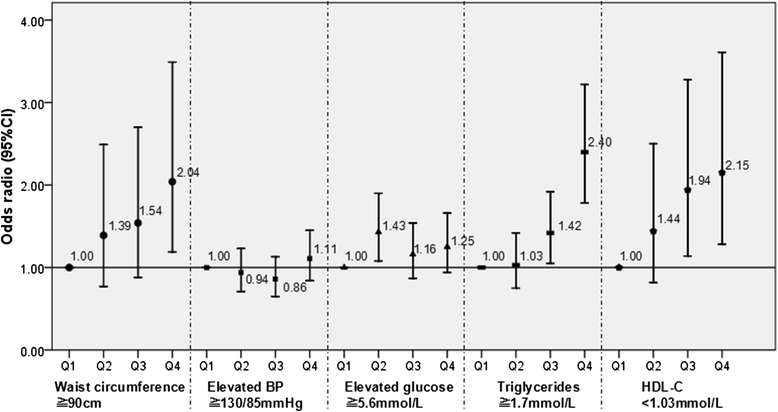High serum ferritin level is an independent risk factor for metabolic syndrome in a Chinese male cohort population
- PMID: 25741386
- PMCID: PMC4349689
- DOI: 10.1186/s13098-015-0004-9
High serum ferritin level is an independent risk factor for metabolic syndrome in a Chinese male cohort population
Abstract
Background: Elevated serum ferritin levels have been reported to contribute to metabolic syndrome (MetS). We examined the association of serum ferritin levels with the development of MetS in a representative sample of Chinese male adult population.
Method: The data came from the 2009-2013 Fangchenggang Area Males Health and Examination Survey (FAMHES). We combined a cross-sectional study of 2417 males and a longitudinal study of 857 males who participated in the FAMHES.
Result: The serum ferritin level of MetS was higher than that of nonMetS (median and percentiles 25-75: 447.4 (294.1-612.4) vs. 302.4 (215.0-435.8) ng/ml, p < 0.01). A positive correlation between ferritin concentrations and blood pressure (Systolic BP: R = 0.110, Diastolic BP: R = 0.158), waist circumference (R = 0.333), fasting glucose (R = 0.089), triglyceride (R = 0.315) and low high-density lipoprotein cholesterol (R = 0.130) was significant (all p < 0.001). Compared with the level of ferritin in the group with no MetS component, the group with all five MetS components had a higher ferritin level (554.7 (340.1-606.4) vs. 274.2 (198.2-384.4) ng/ml). The odd radio (OR) was higher for MetS in the highest ferritin quartile (OR = 2.29, 95% CI = 1.47-3.54) compared with the lowest ferritin quartile after adjustment for multi-factors. After 4-year follow up, 79 subjects newly diagnosed with MetS in 857 cohort male participants in 2013. Compared with the lowest ferritin quartile, the RR of the highest ferritin quartile was 2.55 (95% CI = 1.30-5.00) after multiple adjustments (p < 0.01).
Conclusion: Our findings confirm that the serum ferritin level is associated with the independent components of MetS, and elevated ferritin level is an independent risk factor for MetS development in the Chinese male population during the 4-year follow-up period.
Keywords: Central obesity; High-density lipoprotein cholesterol; Hypertension; Metabolic syndrome; Serum ferritin; Triglycerides.
Figures



Similar articles
-
Association of serum ferritin with insulin resistance, abdominal obesity, and metabolic syndrome in Korean adolescent and adults: The Korean National Health and Nutrition Examination Survey, 2008 to 2011.Medicine (Baltimore). 2017 Feb;96(8):e6179. doi: 10.1097/MD.0000000000006179. Medicine (Baltimore). 2017. PMID: 28225503 Free PMC article.
-
Cross-sectional and longitudinal associations between serum uric acid and metabolic syndrome: Results from Fangchenggang Area Male Health and Examination Survey in China.Clin Chim Acta. 2015 Jun 15;446:226-30. doi: 10.1016/j.cca.2015.04.019. Epub 2015 Apr 23. Clin Chim Acta. 2015. PMID: 25913163
-
Serum ferritin levels and the development of metabolic syndrome and its components: a 6.5-year follow-up study.Diabetol Metab Syndr. 2014 Oct 26;6(1):114. doi: 10.1186/1758-5996-6-114. eCollection 2014. Diabetol Metab Syndr. 2014. PMID: 25371712 Free PMC article.
-
Association of endothelin-1 and matrix metallopeptidase-9 with metabolic syndrome in middle-aged and older adults.Diabetol Metab Syndr. 2015 Dec 10;7:111. doi: 10.1186/s13098-015-0108-2. eCollection 2015. Diabetol Metab Syndr. 2015. PMID: 26692905 Free PMC article.
-
Erythropoietin, ferritin, haptoglobin, hemoglobin and transferrin receptor in metabolic syndrome: a case control study.Cardiovasc Diabetol. 2012 Sep 27;11:116. doi: 10.1186/1475-2840-11-116. Cardiovasc Diabetol. 2012. PMID: 23016887 Free PMC article.
Cited by
-
Association of serum ferritin with insulin resistance, abdominal obesity, and metabolic syndrome in Korean adolescent and adults: The Korean National Health and Nutrition Examination Survey, 2008 to 2011.Medicine (Baltimore). 2017 Feb;96(8):e6179. doi: 10.1097/MD.0000000000006179. Medicine (Baltimore). 2017. PMID: 28225503 Free PMC article.
-
Association of body mass index, waist circumference, and metabolic syndrome with serum cystatin C in a Chinese population.Medicine (Baltimore). 2017 Mar;96(10):e6289. doi: 10.1097/MD.0000000000006289. Medicine (Baltimore). 2017. PMID: 28272253 Free PMC article.
-
Dose-response relationship of serum ferritin and dietary iron intake with metabolic syndrome and non-alcoholic fatty liver disease incidence: a systematic review and meta-analysis.Front Nutr. 2024 Oct 1;11:1437681. doi: 10.3389/fnut.2024.1437681. eCollection 2024. Front Nutr. 2024. PMID: 39410926 Free PMC article.
-
Association of serum ferritin with metabolic syndrome in eight cities in China.Food Sci Nutr. 2020 Feb 3;8(3):1406-1414. doi: 10.1002/fsn3.1408. eCollection 2020 Mar. Food Sci Nutr. 2020. PMID: 32180950 Free PMC article.
-
Association of Metabolic Syndrome and Hyperferritinemia in Patients at Cardiovascular Risk.Diabetes Metab Syndr Obes. 2020 Sep 24;13:3239-3248. doi: 10.2147/DMSO.S271050. eCollection 2020. Diabetes Metab Syndr Obes. 2020. PMID: 33061489 Free PMC article.
References
-
- Giudice A, Crispo A, Massimiliano G, D’Arena G, Tecce MF, Grimaldi M, et al. Metabolic syndrome, insulin resistance, circadian disruption, antioxidants and pancreatic carcinoma: an overview. J Gastrointestin Liver Dis. 2014;23(1):73–7. - PubMed
LinkOut - more resources
Full Text Sources
Other Literature Sources

